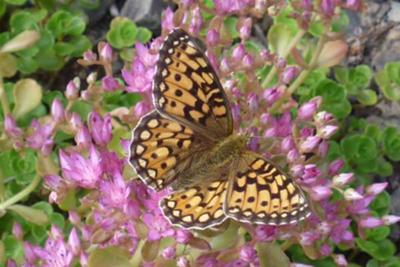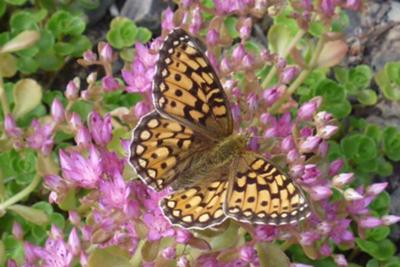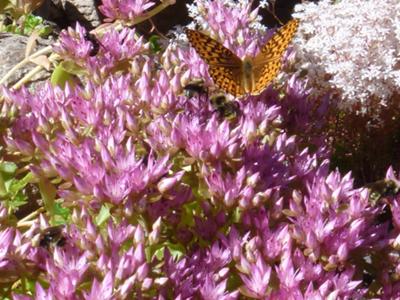by Jacki
(Grand Forks, B.C. Canada)



Finally, I heard back from Bamona, Butterflies and Moths of North America, about my sighting of this incredible butterfly.
I’ve been thinking it was a Mormon Fritillary, a close relative, but now it’s been identified as Speyeria zerene, the Zerene Fritillary.
These beautiful insects are totally attracted to Sedum as it blooms. The sequence starts with Sedum spurium album ‘Superbum’, a white flowered type, and the others open over the span of two months, ending with a bang at the middle of August.
The Zerene fritillary hangs out with many Great Spangled Fritillaries, which occupy the same niche – nectar sipping as adults, violet eating as caterpillars. The larvae hatch from eggs in the fall, but don’t start to eat until spring, hibernating in leaf litter over the winter.
Many of the Zerene Fritillaries sub species that have evolved separated from other populations are seriously endangered as their habitat becomes destroyed by recreational use; a great argument against allowing all terrain vehicles to tear up our forests and wild places.
I plan on planting some more of the lovely and fragrant Viola adunca, just so these delightful butterflies have a host plant for their young.
Mormon Fritillary
by Jacki
(Grand Forks, B.C. Canada)

Speyeria mormonia, Mormon Fritillary
This is another beautiful fritillary – although not as numerous as Speyeria cybele, the Great Spangled Fritillary. In fact, out of the hundred or so Speyeria cybele that visited, there were only maybe two of this one, Speyeria mormonia, the Mormon Fritillary. They look very similar on first glance, but are paler, with more variation in the lacy edged wings.
They hang out together with the Great Spangled Fritillary and feast on the Sedum and many other perennial plants that bloom from mid July to the end of August.
It’s fascinating to watch them hang upside down on the Stachys lanata – Lambs Ears, and that is pretty much the only time to get pictures of them – when they’re blissed out on the nectar.
Compare this fritillary with the Great Spangled Fritillary Butterfly
Update: this has now been identified as Speyeria zerene, the Zerene Fritillary.
Great Spangled Fritillary Butterfly
by Jacki
(Grand Forks, B.C. Canada)




With visitors like this, who needs flowers? Oh, they do of course! Great Spangled Fritillaries are very fond of Sedum, and will visit other xeric plants as well in your butterfly garden.
The caterpillar host plant is violet leaves, so if you have some shady woodland, this beautiful butterfly just might decide to stay and raise a family. Interestingly, the caterpillars are nocturnal, and only eat at night. During the day, they hide somewhere away from their food source.
The more western populations have an interesting difference – the females are much lighter in colour, so there is a marked difference in the male colouration and the female.
There are many similar butterflies, making this a challenge to really identify correctly.
Specific scientific name: Speyeria cybele
See more butterfly species here:


